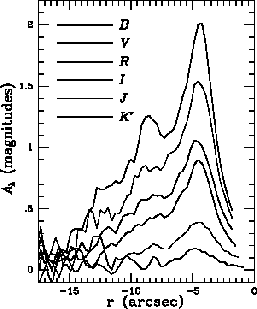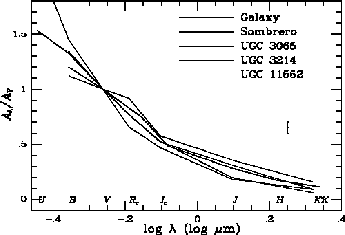The following contribution appeared in:
``The Opacity of Spiral
Disks''
eds.: J.I. Davies & D. Burstein (Dordrecht: Kluwer), p. 185
Dust extinction in highly inclined spirals
J.H. Knapen1, J.E. Beckman1, R.A. Jansen2, R.F. Peletier123 and R. Hes2
1 Instituto de Astrofísica de Canarias, E-38200 La
Laguna, Tenerife, Spain
2 Kapteyn Astronomical Institute, Postbus~800, NL-9700~AV
Groningen, The Netherlands
3 Observatorio del Roque de los Muchachos, Apartado 321,
E-38700 Santa Cruz de la Palma, Spain
Abstract
|
We recently studied a small number of highly inclined spiral galaxies, and used their special geometry to determine absolute extinction values of the dust in their dust lanes. We apply a simple model of a uniform mixture of stars and dust to the data, and find that the extinction values in these galaxies are the same as those making up the Galactic extinction law. This Galactic law seems to be universally applicable. |
|
An important question for the subject of how the opacity of spiral discs
can influence the interpretation of observations of galaxies is whether
the properties of the dust in external galaxies differ widely, or even
at all, from those in our own Galaxy. It is not obvious that one can
assume that the Galactic extinction law is in fact universal when
discussing dust in external spirals. |
|
Recently we studied a few more highly inclined spiral galaxies with a geometry very much like that of the Sombrero galaxy: a dust lane along the major axis, but slightly offset from the centre of the galaxy (Jansen et al. 1994). We obtained images in the optical B, V, Rand I bands, and in the NIR J and K' bands of the four galaxies, UGC 3065, UGC 3214, UGC 11552 and MCG 02-10-009. In all the galaxies it is clearly seen that although the dust lane cuts out significant emission from one half of the galaxy in the bluer optical bands, the effects of dust extinction gradually become less important toward the red, and have almost completely disappeared in the K band.
We aligned the frames using positions of foreground stars, and after
determining the correct major axis position, subtracted the unobscured
part of the minor axis light profile from the dust-obscured part, thus
obtaining dust extinction profiles across the dust lanes, for each
photometric band studied. In Figure 1 we show
these differential profiles for one of the galaxies, UGC 3065. The
extinction is given in absolute magnitudes, which are derived as an
intrinsic product of the differential method used to produce the
extinction profiles. The extinction is strongest, as expected, in the
B band, with a peak value of AB = 2.3
mag, and gradually weakens while moving towards longer wavelengths.
From these dust extinction profiles we then derived, for each galaxy,
ratios A
In fact, measured values of A |
Last updated: Nov 15, 2000 (minor style change)


 / AV as
functions of the logarithm of the wavelength for the observed data of
UGC 3065, UGC 3214 and UGC 11552, fitted with a model where stars and
dust are uniformly mixed in the dust lane. Results are compared to the
extinction law for our Galaxy (solid line) and for the Sombrero
galaxy.
/ AV as
functions of the logarithm of the wavelength for the observed data of
UGC 3065, UGC 3214 and UGC 11552, fitted with a model where stars and
dust are uniformly mixed in the dust lane. Results are compared to the
extinction law for our Galaxy (solid line) and for the Sombrero
galaxy.